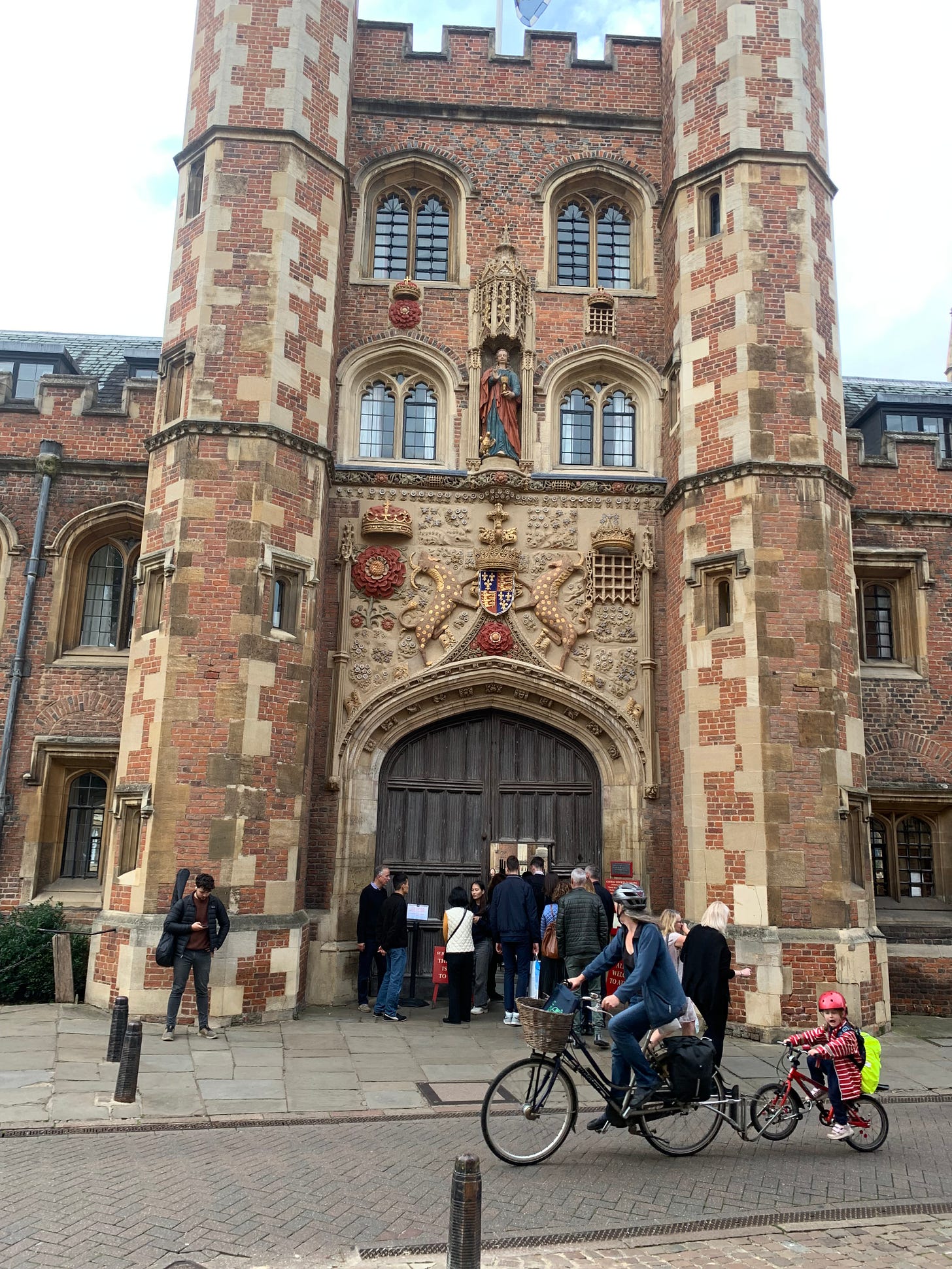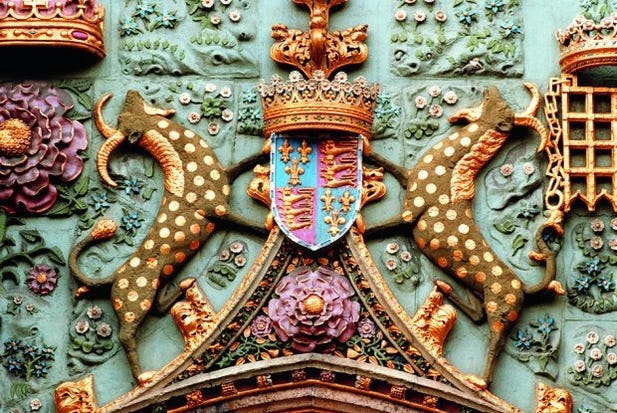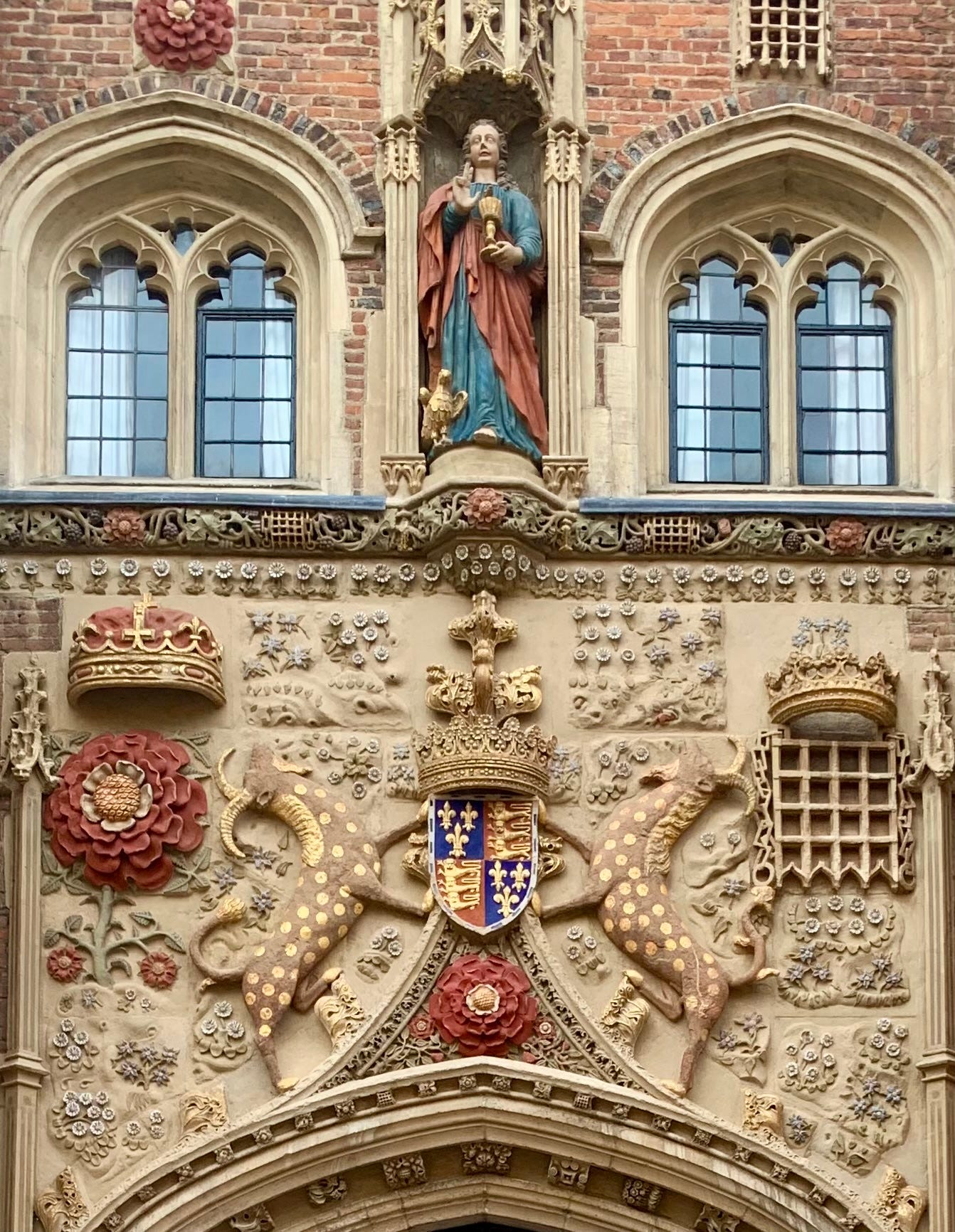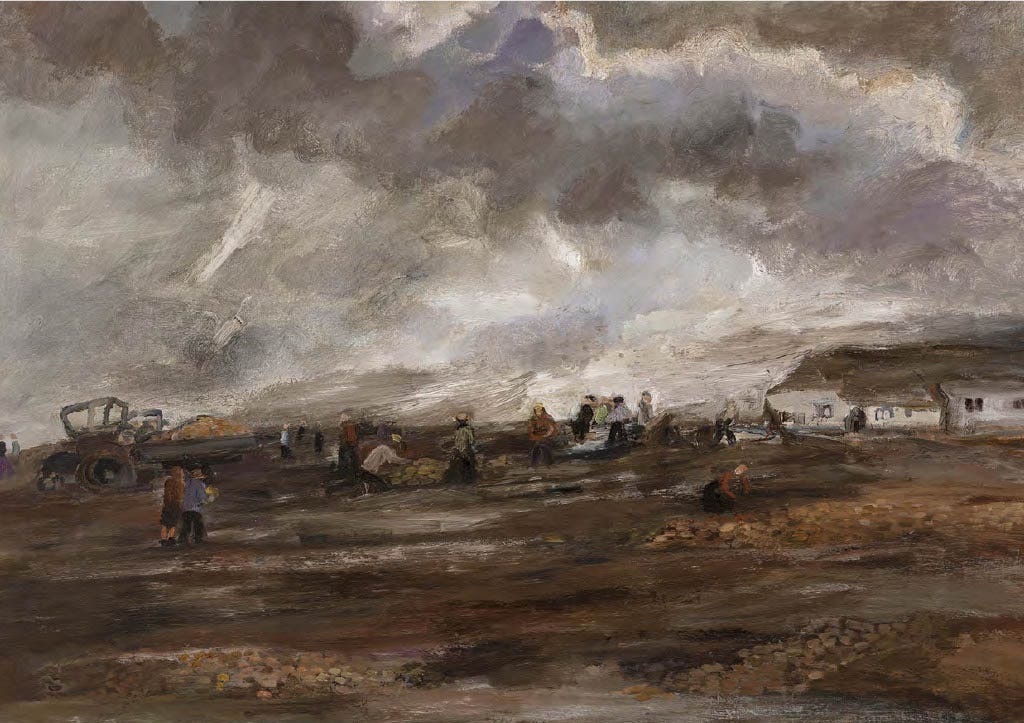Cambridge Notebook #12
Restoration and bling | Colours in The Enchanted April | Autumn Reading
Hello, and welcome to the twelfth in my Cambridge Notebook series. It’s almost a year since I first started publishing on Substack, and I’m very grateful to you all for signing up to receive my newsletters over the past 12 months. This week is about a restoration project in Cambridge, cheerful and nostalgic recommendations for those long winter evenings and sunny projects to look forward to in 2025. Thank you so much for reading!
(PS I’ve just added a brief selection of not-to-be-missed exhibitions & events, see section 4 below. More autumn books coming soon.)
1. Restoration
If, like me over the past few months, you happened to be cycling down Trinity Street in Cambridge, concentrating on not colliding with tourists, you might not have noticed the scaffolding covering the Great Gate of St John’s College. But recently the covers have been removed to reveal what’s been going on beneath it: a cleaning-up and conserving of the decorative stonework over the Gate.
It’s an event that takes place every fifty years or so, to restore ‘the College’s second most photographed feature after the Bridge of Sighs’ according to this recent article on the St John’s website. Even for people who pass it every day, the restoration of the Great Gate is worth looking at more closely. Here’s a snap I took last week.
The stonework above the gate is decorated with Lady Margaret Beaufort’s coat of arms and the mythical creature holding up her family crest on either side is a ‘yale’: a magnificent antelope-like beast with a goat’s head and impressive swivelling horns. Above the crest is a statue of St John the Evangelist holding up two fingers in blessing and at his feet there’s an eagle, now an emblem of the College.
Margaret Beaufort (1443-1509) was one of the richest and most powerful women in English Tudor history. She was also a scholar who sponsored several early printers, including Caxton, and translated the Imitation of Christ by Thomas à Kempis for publication.1 Cambridge University benefited greatly from her interest in scholarship, as she was instrumental in establishing St John’s and Christ’s Colleges and persuaded her son King Henry VII to promote the successful completion of King’s College Chapel.

You can read more about her Cambridge history on the websites of Christ’s and St John’s (see footnote below). Reading the BBC History Magazine’s ‘Margaret Beaufort: mother of the Tudors’ I spotted a photograph of the St John’s Great Gate carvings, taken not long after the previous restoration in 1982. The background is sea green, the crest has been painted in bright turquoise and acid pink, and those yales look positively ‘blingy’ in their shiny gold polka dots and horns. At first I assumed someone at Getty Images had ‘enhanced’ it, but apparently not; the 1980s colour scheme was based on one devised in the mid-1930s by Ernest Tristram, a professor at the Royal College of Art.
Compare those boiled-sweet colours with the 2024 restoration work below. The conservator Matthew Beesley’s approach has been ‘to let the carved stone speak for itself’, deploying the 24-carat gilding sparingly. The stronger colours have been used for organic elements such as the roses and (in honour of Margaret of Beaufort) the white ‘marguerite’ daisies. Beesley’s approach ‘has been to blend his expert scientific understanding of the geology of stone and the chemistry of paint with his equally expert aesthetic sense of the Tudor approach to polychromy (the art of painting in several colours, especially when applied to ancient pottery, sculpture or architecture’).2
This delicate but hard-wearing restoration work brings renewed beauty to this carving from 1511-1516 and it’s a wonderful tribute both to the artistry of the original stonemasons3 and to the lasting influence of Margaret Beaufort on this ancient university. Worth slowing down on your bicycle to take it in.
2. October-November’s book club
Speaking of roses and daisies, no one does colourful garden descriptions better than Elizabeth von Arnim. This is from Chapter 8 of The Enchanted April (1922), when Mrs. Wilkins and Mrs. Arbuthnot first encounter class-mixing among flowers in the gardens of San Salvatore (in real life Castello Brown in Portofino, Italy).
‘Colour seemed flung down anyhow, anywhere; every sort of colour, piled up in heaps, pouring along in rivers—the periwinkles looked exactly as if they were being poured down each side of the steps—and flowers that grow only in borders in England, proud flowers keeping themselves to themselves over there, such as the great blue irises and the lavender, were being jostled by small, shining common things like dandelions and daisies and the white bells of the wild onion, and only seemed the better and the more exuberant for it.’
This month’s discussion of The Enchanted April is available to all, so you can decide if this is something you’d like to read, participate in and (if you like) start your own ‘threads’ (topics of discussion). It’s very easy, honestly!
You can have a look at our ‘Chat’ feature by clicking on the link here:
From November, the forum will be a perk for paying subscribers only (thank you so much for your support). If you’re interested in joining us but can’t upgrade at the moment, please message me and I’ll happily send you three months’ worth of free membership.
3. Autumn reading (more coming soon!)
‘Are there sometimes other children here?’ Mrs Oldknow looked at him as if she would like to know everything about him before she answered. ‘Yes,’ she said, ‘sometimes.’
This month marks the publication of the 70th Anniversary edition of The Children of Green Knowe by Lucy M. Boston. This new edition features the original black and white illustrations by Lucy Boston’s son, Peter Boston, in the form he wished: right to the edge of the pages, without a border around them. To celebrate the anniversary, here’s my post from earlier this year about Lucy Boston.
Memories in a House
Previously I wrote about the artist and writer Gwen Raverat’s lifelong love of the River Cam, and how returning to live by the river in Cambridge inspired her later art and writing. It got me thinking about another beautiful riverside house, the Manor at Hemingford Grey, which overlooks …
4. Exhibitions and events
This is the final week of a free exhibition at Clare Hall Cambridge of a selection of work by British artist Sheila Fell (1931-1979), in advance of a major re-evaluation of her art and career. Fell attended St Martin’s School of Art in London, where she developed friendships with Frank Auerbach and Leon Kossoff, and kept her studio. She is famous for her brooding landscapes of Aspatria in West Cumbria, where she grew up, and L.S. Lowry was a close friend and noted fan of her work (his influence can perhaps be seen in the small figures in the painting above). ‘Cumberland is very dark’, Sheila Fell explained, ‘but being dark it is also very brilliant.’ Andrew and Eleanor Bradley’s catalogue raisonné of Fell’s work will be published in 2025.
‘Women and Cambridge English: The First Seventy Years (1869-1939)’ is a free exhibition currently showing at the Benson Gallery in the English Faculty Library, Cambridge. I haven’t been to see it yet, but hoping that Cambridge Ladies’ Dining Society member Ellen Crofts Darwin, who taught English literature at Newnham College from 1878-1883, will feature.
On 3 November at Murray Edwards College there’s a screening of The Atom: A Love Affair is ‘an ambitious, international documentary film exploring the West's rollercoaster love-hate relationship with nuclear power over the past 75 years.’ It’s directed by talented director and Substack writer
and she will be present for a Q&A with Dorothy Byrne following the showing. All tickets are currently booked, but for more information check the website here.
5. Recommended Substacks
This month I’ve enjoyed discovering the art of Elinor Bellingham-Smith in ‘A Restless Life’ by
. It’s heartening to learn that although Bellingham-Smith found fame only later in life, it brought her some wonderful new friendships. ‘The novelist Elizabeth Taylor had swept into the private view and thrillingly bought a painting. They were to become great friends, the writer frequently inviting her to stay, giving her valuable solitary painting time. Elinor said, “we suffered from the same self-doubt about our work and the horror of being exposed at private views and publishing parties.”’‘Where would we be without some fortune? A piece of luck which meant we had books in our house?,’
asks in her important post, ‘Strong Beauty’. She describes how meeting some extraordinary women inspired her involvement in a special project for the RHS Chelsea Flower Show 2025: a show garden in support of The Glasshouse, which provides horticulture training and employment to women in prison and recently released from prison. ‘Nearly all of these women have been the subject of abuse and violence in their lives and many of their crimes are linked to this experience,’ the organizers write. ‘The opportunity to step away from the noisy, overwhelming, political world of prison into a quiet glasshouse has a profound and positive effect on women’s mental health.’And don’t miss the first fifty things that came to ’s mind this week when he thought about what most cheered him up, in ‘The 100 greatest’.
6. And finally…
What’s your favourite thing about this season? If you’re in the northern hemisphere, is it the misty mornings, long walks to appreciate the last of the autumn leaves, or curling up with a good book by the fire? In Cambridge, the student rowers pictured above are out on the river not long after sunrise, but many of us feel a little gloomy as we reset our clocks tonight, aware of the days getting shorter. I’d love to know what brings you cheer these days, and especially what you’re enjoying reading.
See Lady Margaret Beaufort, Christ’s College website (26.10.24); ‘Women and their books’ St John’s College website (26.10.24).
‘The tower was built by William Swayne, the master mason who was also employed at King's College Chapel; here he produced a fine fan vault on a much smaller scale.’ https://www.joh.cam.ac.uk/great-gate (28.10.24)













Lucy Boston dear to my heart not only for the books but because I too am a quilter. On the day of our visit to Hemingford Grey we were the only booking so Diana allowed me a good long look at all the quilts. Lucy is hugely respected in the quilting world especially given she stitched by hand and designed such amazing patterns from a huge range of fabrics…no easy task. There are dedicated groups making replicas of her iconic Patchwork of the Crosses, and just looking at those colours you’ve shared at St Johns…well I can guarantee had Lucy seen them she would have been inspired by them.
"Boiled sweet colors" indeed! The history of Margaret Beaufort and her generosity to the colleges of Cambridge combined so well with your study of two distinctive restorations of the Bridge of Sighs. The current restoration looks stunning in the photos. I haven't ever been to Cambridge, so this visit was a treat for me.